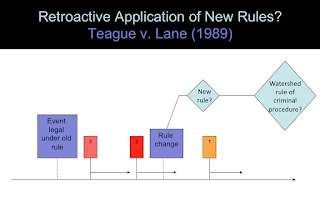In anticipation of the November ballot, my colleagues and I at UC Hastings made a series of nonpartisan informational videos explaining the 2016 propositions. Here’s the video I made on Prop 62:
On this blog I also make endorsements. It’s an unequivocal YES, YES, YES on 62.
It’s not a particularly well-kept secret that I vehemently oppose the death penalty for all the obvious reasons: it’s inhumane, there’s no good evidence that it deters murderers, there are grave concerns about the fairness of its application, and with social psychologists estimating that 5% of all convictions are wrongful, there is also the grave risk of mistake. Add to that the important factor I discuss in Cheap on Crime–the expenditure involved in capital punishment–and repeal should be an obvious choice.
But I’d like to address this post not to the folks who are convinced, for moral reasons, that repeal is the right choice. I’d like to talk to decent, reasonable people who are on the fence about the death penalty, because they feel that some people–serial murderers, people who kill and assault little children, etc.–should have an especially harsh sentence reserved for them. Even if you are such a person, you should vote yes on 62. Here’s why.
In November we’ll be voting not about the philosophical merits of the death penalty, but on whether to keep it as it is practiced here in California. Here are some facts, not opinions: we currently have 751 people on death row. Since the reinstatement of the death penalty in 1978 we executed a grand total of 13 people. Meanwhile, 90 people died of natural causes. They spend decades on death row, during which they are held in expensive conditions in a dilapidated facility, and they also litigate. Their confinement, and especially their litigation, is costing us $150 million a year, which would be saved if all these people were to be transferred tomorrow to general population. And most of these death row inmates are not the “worst of the worst” for whom you’d like to reserve the death penalty.
I get that you think that in principle there should be something special for really heinous crimes. But we don’t live in a principle. We live in California. And in California, this is expensive and it doesn’t work.
“So the death penalty is broken,” you say. “Why not fix it? Why not make it cost-effective, and then I can continue to support it?”
There is a proposition on the ballot that argues just that–Prop 66. Its proponents, mostly county district attorneys, argue that adding lawyers and shortening procedures would save money and allow California to retain the death penalty. Here’s the informational video I made of Prop 66:
The two reforms proposed by 66 are unrealistic, expensive, and very risky. They would not solve the problem. I strongly oppose it and urge you to vote No on 66.
Currently, each death row inmate receives two attorneys at the state’s expense to litigate his/her case. “Quelle luxe!” I hear you say. Well, not so much. The Habeas Corpus Resource Center has a whooping grand total of 34 attorneys, who get assigned the hundreds of cases on death row. According to the Legislative Analyst’s Office, as of September 2015, 57 individuals were awaiting appointment of counsel in direct appeals and 358 individuals were awaiting appointment of counsel in habeas corpus proceedings. Those are hundreds of people whose lives depend on a determination of their legal claims, who have to wait an average of 16 years to get an attorney. That’s why it takes so long to execute people in California.
Hiring and training more attorneys to take on capital cases would cost tens of millions of dollars a year–on top of the $150 million we’re already paying by having capital punishment. While I’d love for there to be more jobs for my students, this is an unnecessary expenditure we can ill-afford.
What’s worse, Prop 66 supporters propose to shorten the times for appellate and habeas proceedings. But there’s a reason why these procedures take time. It’s because they have the potential of diminishing the risk of horrible mistakes. When someone does life without parole and is found to be innocent, their life has been detailed, but amends can be made. When an innocent person has been executed, there are no amends. The risk of a mistake is graver than we can tolerate: remember, a conservative estimate puts wrongful convictions at 5% of all convictions.
There is no fix here that saves money and prevents injustice. And even if you think you’re willing to compromise, ask yourself–how much is it really worth to you to keep 751 people on death row? Is it really conscionable to pay $150 million annually to keep this going?
Yes on 62. No on 66.




